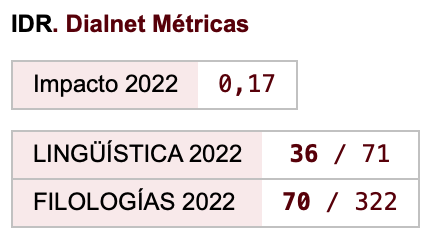Learning objects in the teaching of specific vocabulary to English for Conservation and Restoration
Keywords:
subject specific vocabulary, ICT, learning object, EFL, ESP, conservation and restoration of cultural assetsAbstract
In the English course included in the degree in Art Conservation and Restoration at the University of La Laguna (Spain), the inexistence of commercial teaching resources suitable for this area and, more particularly, for the learning of specialized vocabulary, has become evident. As a result, as is often the case in the field of English for Specific Purposes, the lecturer has gradually created her own materials using information and communication technologies (ICT). The experience gained over the first three years of existence of the degree, during which the ICT materials supported the face-to-face teaching of highly heterogeneous groups, has led to the present research. Bearing in mind the previous experience, the teacher has designed a didactic proposal based on a collection of learning objects (i.e. discrete and reusable content units hosted on the Moodle virtual platform) and on a teaching methodology based on the principles of the flipped classroom. This study shows the main results of the evaluation of such a didactic proposal, which was implemented in the first semester of the academic year 2014-2015. In particular, the analysis aims to assess its effectiveness for the learning of specialized vocabulary, as well as the degree of satisfaction on the part of the students. The data suggest that the overall outcome has been positive in both respects.
Downloads
References
Adell, J., Bellver, T., y Bellver, C. (2010). Entornos virtuales de aprendizaje y estándares de e-learning. En C. Coll, y C. Monereo (Coords.), Psicología de la educación virtual (pp. 274-298). Madrid: Morata.
Aznar, F. (2004). Diccionario políglota de las Bellas Artes. Garafía, La Palma: Proyecto Editorial Arsdidas, Ediciones Alternativas.
Burns, A. (2011). Action research in the field of second language teaching and learning. En E. Hinkel (Coord.), Handbook of research in second language teaching and learning, Vol II (pp. 237-253). Nueva York, NY: Routledge.
Chung, T., y Nation, P. (2004). Identifying technical vocabulary. System, 32(2), 251-263. doi:10.1016/j.system.2003.11.008
Dudley-Evans, T., y St John, M. J. (1998). Developments in English for specific purposes: a multi-disciplinary approach. Cambridge: Cambridge University Press.
Ellis, M., y Johnson, C. (1994). Teaching business English. Oxford: Oxford University Press.
Fernández, J. C., Muriel, E., Hípola, P., Pérez, A., Martín, F., Martín, O., Riera, P. y Vives, J. (2009). Derechos de autor en plataformas e-learning. Secciones "Conflictos entre e-learning y los derechos de autor" y "Posibles soluciones a los conflictos entre e-learning y los derechos de autor". <http://www.ugr.es/~derechosdeautor/index.html> [17/05/ 2015].
Folse, K. S. (2004). Vocabulary myths. Applying second language research to classroom teaching. Ann Arbor, MI: The University of Michigan Press.
Fraser, S. (2006). Factors affecting the learnability of technical vocabulary: findings from a specialized corpus. Foreign Language Education and Research Center, Hiroshima University, 15, 123-142. <http://ir.lib.hiroshima-u.ac.jp/files/public/32299/20141016185750293029/ h-gaikokugokenkyu_15_123.pdf> [17/05/2015].
Libro Blanco de los Títulos de Grado en Bellas Artes, Diseño y Restauración. (2004). Agencia Nacional de Evaluación de la Calidad y Acreditación (ANECA). <http://www.aneca.es/var/ media/150332/libroblanco_bellasartes_def.pdf> [17/05/2015].
Luzón, M. J. (2009). Learning academic and professional English online: integrating technology, language learning and disciplinary knowledge. En I. González-Pueyo, C. Foz, M. Jaime y M. J. Luzón (Coords.), Teaching academic and professional English online (pp. 11-33). Berna: Peter Lang.
Martínez, C., y Rico, L. (2003). Diccionario técnico Akal de conservación y restauración de bienes culturales: español, alemán, inglés, italiano, francés. Madrid: Akal.
Nation, I. S. P. (2001). Learning vocabulary in another language. Cambridge: Cambridge University Press.
Paribakht, T. S., y Wesche, M. (1993). Reading comprehension and second language development in a comprehension-based ESL program. TESL Canada Journal, 11, 9-29.
Read, J. (2000). Assessing vocabulary. Cambridge: Cambridge University Press.
Sams, A., y Bergmann, J. (2013). Flip your students’ learning. Educational Leadership, 70(6), 16-20. < http://www.ascd.org/publications/educational-leadership/mar13/vol70/num06/Flip-Your-Students'-Learning.aspx > [17/05/2015].
Schmitt, N. (2000). Vocabulary in language teaching. Cambridge: Cambridge University Press.
Verifica. Memoria para la solicitud de verificación del Título Oficial de Grado en Conservación y Restauración de Bienes Culturales por la ULL. Documento interno de trabajo de la Facultad de Bellas Artes de la Universidad de La Laguna, recibido por correo electrónico el 27 de abril de 2012.
Watson, J. (2010). A case study: developing learning objects with an explicit learning design. Electronic Journal of e-Learning, 8(1), 41-50. <http://files.eric.ed.gov/fulltext/EJ880098.pdf> [17/05/2015].
Downloads
Published
How to Cite
Issue
Section
License
Authors who publish with this journal agree to the following terms:
- Authors retain copyright and grant the journal right of first publication with the work simultaneously licensed under a Creative Commons Attribution License that allows others to share the work with an acknowledgement of the work's authorship and initial publication in this journal.
- Authors are able to enter into separate, additional contractual arrangements for the non-exclusive distribution of the journal's published version of the work (e.g., post it to an institutional repository or publish it in a book), with an acknowledgement of its initial publication in this journal.
- Authors are permitted and encouraged to post their work online (e.g., in institutional repositories or on their website) prior to and during the submission process, as it can lead to productive exchanges, as well as earlier and greater citation of published work (See The Effect of Open Access).

Revista de Lenguas para fines específicos is licensed under a Creative Commons Reconocimiento-NoComercial-SinObraDerivada 4.0 Internacional License.























